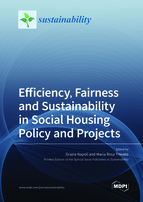Efficiency, Fairness and Sustainability in Social Housing Policy and Projects
A special issue of Sustainability (ISSN 2071-1050). This special issue belongs to the section "Sustainability in Geographic Science".
Deadline for manuscript submissions: closed (15 April 2022) | Viewed by 43860
Special Issue Editors
Interests: sustainable economic development; real estate valuation; real estate market; environmental economics; environmental impact assessment; urban sustainability; simulation and evaluation models for planning and urban development; territorial and environmental public policies; building and district energy efficiency; financial analysis; financial economics; urban economics; econometrics; decision support systems; multicriteria analysis and evaluation; energy poverty; energy community
Special Issues, Collections and Topics in MDPI journals
Interests: environmental economics; real estate economics; urban economics; urban and land management; urban and land sustainability; cultural resources valuation; multiple criteria decision analysis (MCDA); datamining; GIS
Special Issues, Collections and Topics in MDPI journals
Special Issue Information
Dear Colleagues,
Affordable housing for low-income households is still a serious social problem, and social housing can support the achievement of the objectives of economic feasibility, fairness, and social sustainability.
Social housing is a complex topic that is interrelated with several fields of study—politics, ethics, economics, environment, architecture, and technology. In other words, social policy, at a national and local level, as well as public and private resources, and innovative tax and credit systems, are all necessary to promote social housing.
Social housing also implies social and urban transformations, and is, consequently, connected to urban planning, urban regeneration projects, real estate market dynamics, and cooperation between public and private stakeholders. In the most advanced proposals, social housing may also include environmental sustainability and technological innovation (energy savings, environmentally friendly materials, etc.), and suggest new models of housing units (co-habitation and the sharing of common spaces).
Furthermore, the decision-making process related to SH policies and projects has to be supported by the evaluation of economic feasibility and assessments on social and environmental sustainability.
This Special Issue of Sustainability offers a platform where all different topics may be presented to recompose the multi-faceted subject within a unified framework.
Prof. Grazia Napoli
Prof. Maria Rosa Trovato
Guest Editors
Manuscript Submission Information
Manuscripts should be submitted online at www.mdpi.com by registering and logging in to this website. Once you are registered, click here to go to the submission form. Manuscripts can be submitted until the deadline. All submissions that pass pre-check are peer-reviewed. Accepted papers will be published continuously in the journal (as soon as accepted) and will be listed together on the special issue website. Research articles, review articles as well as short communications are invited. For planned papers, a title and short abstract (about 100 words) can be sent to the Editorial Office for announcement on this website.
Submitted manuscripts should not have been published previously, nor be under consideration for publication elsewhere (except conference proceedings papers). All manuscripts are thoroughly refereed through a single-blind peer-review process. A guide for authors and other relevant information for submission of manuscripts is available on the Instructions for Authors page. Sustainability is an international peer-reviewed open access semimonthly journal published by MDPI.
Please visit the Instructions for Authors page before submitting a manuscript. The Article Processing Charge (APC) for publication in this open access journal is 2400 CHF (Swiss Francs). Submitted papers should be well formatted and use good English. Authors may use MDPI's English editing service prior to publication or during author revisions.
Keywords
- housing policy
- housing economics
- housing finance
- social housing stock
- real estate market
- economic evaluation of investments
- public private partnership
- multiple criteria decision aid
- subsidies, incentives and benefits
- affordable housing and housing affordability
- social cohesion and management
- fairness and right to the city
- gentrification
- urban regeneration
- social housing investment facility
- income threshold
- energy retrofit in social housing
- sustainable neighbourhoods
- technological innovation
- rent and user costs
- credit conditions and housing price ratio







